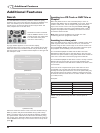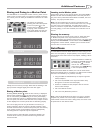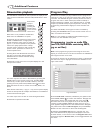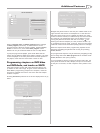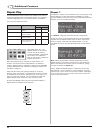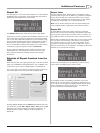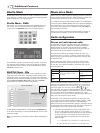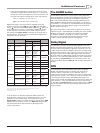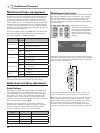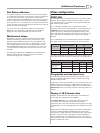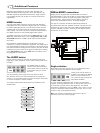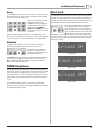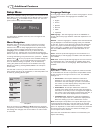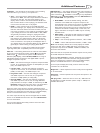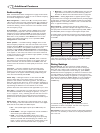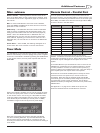
Additional Features
34
UDP-89 User Manual Version 2.0www.hhb.co.uk
Multichannel bass management
Practical surround sound loudspeaker systems frequently have
smaller units in the rear and centre positions, and these may
not offer an extended LF response compared with the main
left and right front speakers. Other systems may not include a
centre speaker at all, or no dedicated sub-woofer. The UDP-89
includes a set of user-selectable options for re-directing some
or the entire frequency spectrum in some channels to different
speakers, to ensure that all programme material in all channels
is reproduced in such systems.
The various options are set in the Audio tab of the Setup menu.
See “Audio settings” on page 40 for more details. The table
below summarises the possibilities available:
SPEAKER SETTING
OPTIONS
EFFECT
Bass Management
Off
Full frequency range is sent to centre and rear
channels
On
LF (<100 Hz) in centre and rear channels is
routed to front L & R speakers
Front Speakers
Large Full frequency range is sent to front channels
Small
LF (<100 Hz) in front channels is routed to
sub-woofer
Center Speaker
Large Full frequency range is sent to centre channel
Small
LF (<100 Hz) in centre channel is routed to
front L & R speakers
Off
All centre channel programme is routed to
front L & R speakers
Surround Speakers
Large Full frequency range is sent to rear channels
Small
LF (<100 Hz) in rear channels is routed to
front L & R channels
Off
All rear channel programme is routed to front
L & R speakers
Sub-woofer
None
All LFE channel programme is routed to front
L & R speakers
Present LFE channel routed to sub-woofer (normal)
Note: The settings of the surround speakers will also affect the
downmix format used for the main left and right outputs.
Audio level and delay adjustment
Audio Volume
Adjustment of overall audio level is available in the UDP-89 via
the VOLUME buttons on the RC-89 remote control unit. The
front panel display confirms the level setting when the buttons
are pressed. The range of level adjustment available is from
-90 dB to 0 dB, in 1 dB increments. If the Vol Down button
continues to be pressed beyond -90 dB, the audio is muted and
the front panel display indicates MUTE.
When the audio output level is set to 0 dB, the balanced
analogue audio outputs are calibrated to produce a maximum
level of +22 dBu. The following table shows some “national
standard” settings in common use in some countries.
VOLUME CONTROL
SETTING
MAX OUTPUT LEVEL USED IN
0dB +22dBu USA, Canada
-4dB +18dBu UK (BBC Standard)
-7dB +15dBu Germany
-10dB +12dBu Germany & elsewhere
Multichannel level trims
It is also possible to adjust the levels of the individual channels of
the analogue multichannel (surround) outputs. This is typically
desirable when different models of speakers are being used in
the rear and/or centre positions from the main front L/R
speakers, and permits the differing sensitivities of the speakers
to be allowed for.
Multichannel level trim is
adjusted from the RC-89 remote
control unit. Pressing either of
the CH SELECT buttons allows
adjustment of the Front Left
channel, the front panel display
showing:
FL +05dB
SACD
Adjustment of the level in the front left channel is made with the
CH LEVEL up-and-down buttons. Other channels may be adjusted
in turn by further presses of the CH SELECT buttons, which will
select the other channels in turn:
CH SELECT
CH SELECT ‘UP’
CH SELECT ‘DOWN’
FRONT
LEFT (FL)
FRONT
RIGHT (FR)
REAR
LEFT (RL)
REAR
RIGHT (RR)
CENTER
(CEN)
LFE
CHANNEL
(SW)
The function and display time out after approx. 5 secs. if no
button is pressed, and the unit reverts to normal operation.
Note: When the main volume control is set to 0 dB, the output
level for each channel is at its maximum. Therefore, to apply
positive gain to each channel level, it is necessary to first turn
down the master volume control by the same amount, i.e.,
to boost the surround channels by 3 dB relative to the other
channels, the master volume must be adjusted by at least -3dB.



